Arduino Bluetooth-Controlled Projects are a great way to automate your creative process. By using a simple smartphone app, you can control your projects wirelessly from anywhere in the world! In this guide, we will answer some of the most common questions about Arduino Bluetooth-Controlled Projects. We will provide useful tips and advice on how to get started with your own project. So what are you waiting for? Let’s get started!
Arduino and Its Benefits
Using an Arduino board and an HC-05 Bluetooth module, it’s possible to create a variety of Arduino Bluetooth-Controlled projects. Whether you’re an experienced programmer or just starting out with microcontrollers, the flexibility of Arduino makes it easy to get into programming quickly.
They feature open source hardware and software, making them accessible to anyone who wants to learn coding and build electronic devices. Plus, they can be programmed using the familiar Arduino integrated development environment (IDE), giving you the ability to write code on your own computer without needing special hardware.

The low cost of Arduino boards also makes them ideal for hobbyists who want to build projects at home. The HC-05 Bluetooth module is a versatile wireless component that allows you to control your Arduino projects from a smartphone or tablet. This opens up new possibilities for making your own remote control devices, connecting devices wirelessly and more.
The combination of Arduino boards and Bluetooth modules make it possible for anyone to build exciting projects which interface with the real world. From robotics to home automation, you’ll be able to create amazing projects quickly and easily with an Arduino board and HC-05 Bluetooth module.
Before starting out on an Arduino project, you need to consider a few things first.
Your budget
The cost of the components for an Arduino project can vary greatly depending on what you’re making. Simple projects with just a few basic components will be much cheaper than projects that require multiple modules and sensors. Make sure to check prices before starting your project so you know how much it will cost and plan accordingly.
If you are new to microcontrollers, then buying an Arduino starter kit is a great way to get started. These kits come with all the essential components you need, such as an Arduino board, jumper wires, resistors, LEDs and more. They also usually include instructions and tutorials which make it easy to build your first project quickly.
For more advanced projects, you may want to buy individual parts instead of kits, as this will give you more flexibility in terms of what components you use. You can usually find the parts online at a variety of stores or search for tutorials on Arduino-related websites to see which components are best for your project.
Your experience
Before starting a project, it’s important to consider your experience level. If you are new to programming and electronics, then it’s best to start with simple projects that don’t require a lot of coding or hardware knowledge. Starting with simple projects is also a great way to learn the basics before moving on to more complex ones.
If you have some experience in programming and electronics, then you may want to try an intermediate project such as an Arduino-controlled robot or home automation system. These types of projects require more coding knowledge but can be very rewarding once completed successfully. [1]
Best Arduino Bluetooth-Controlled Projects
Now that you have an idea of what Arduino and Bluetooth-Controlled projects are, let’s look at some of the best projects you can make using this combination. In this section, we’ll show you some of the most popular projects and give you ideas for your own.
Bluetooth Controlled Car using Arduino
With this project, you can have complete control over your car with the help of Bluetooth and Arduino. This project relies on a car, Arduino board, smartphone, Li-ion Battery SparkFun Dual H-Bridge motor drivers L298 and LED for its construction.
You can create a simple Bluetooth-based remote control car using the components mentioned above. First, prepare the car by mounting the Arduino and motor drivers on it. Next, establish a circuit for connecting all the components to create a simple power supply system. After that, install your smartphone onto the car and use an app to connect it with the Arduino board via Bluetooth. Finally, write down some code in the Arduino IDE and upload it to your board.
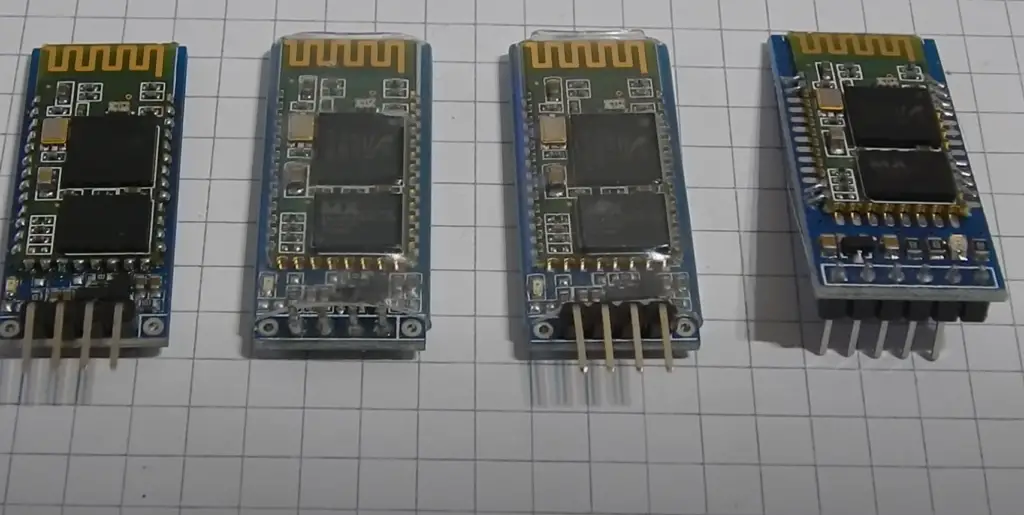
There are plenty of tutorials available online on how to build Bluetooth controlled cars using Arduino. However, if you are facing any issues during the construction process, here are some tips to keep in mind:
- Use an appropriate Li-ion Battery that can power up both the motors and Arduino board simultaneously.
- Try to use a small car for this project since it will be easier to control and maneuver.
- Make sure your smartphone app is compatible with your Arduino Board before connecting them together via Bluetooth.
- Make sure your code matches the hardware setup of the car so it can perform its functions properly.
- Test out the car after completing each step of building it before assembling all components together. This will help you find potential problems early on and makes it easier to debug.
You also can use nearly any car chassis provided it can fit all the components and also can reach high speeds. Once you have completed the construction process, you can provide more functionality to your Bluetooth-controlled car such as adding lights and sensors for obstacle navigation. Have fun!
Arduino Bluetooth LED Control System
Another popular Arduino project is creating an LED control system using Bluetooth. This project can be used to turn on, off and dim LEDs from your Android smartphone or tablet.
To get started, you will need the following components:
- Bluetooth module HC 05/06
- Android application
- LED
- Arduino UNO
Basically, a Bluetooth platform to an android application, you can conveniently send instructions directly to hardware modules. On receiving data as “1” the LED blinks and turns off when it’s “0”. This Arduino project is simple yet useful, and requires very few components.
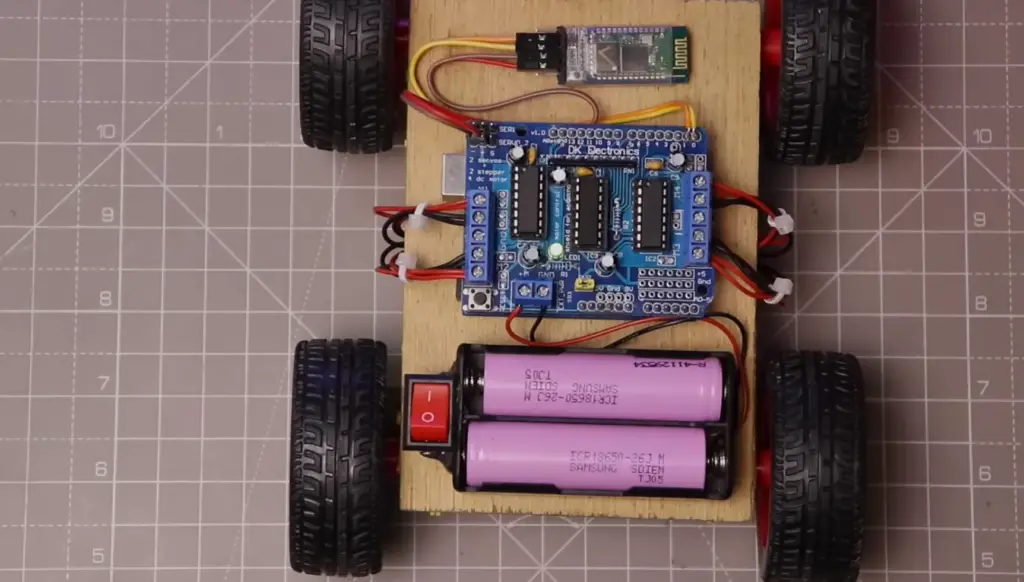
Smartphone-Controlled Arduino 4WD Robot Car
We already covered a Bluetooth controlled car before, this time we will create one that you can control with an Android app.
This project will require:
- Arduino UNO
- HC-06 Bluetooth Module
- 4WD Smart Robot Car Chassis Kit
- SparkFun Dual H-Bridge motor drivers L298
- LED (generic)×4
- Buzzer×1
- Resistor 221 ohm
We can start by connecting the Arduino, motor drivers and HC-06 Bluetooth module as described in our previous guide.
Next, we need to create an Android App that will communicate with the HC-06 Bluetooth Module. This can be done using MIT’s App Inventor 2 platform. With this tool you can design your app by dragging and dropping components into place via a graphical user interface (GUI). The app needs to contain seven different buttons: forward, back, left turn, right turn, stop, increase speed and decrease speed. Each of these buttons should send out a unique character string when pressed which will be used by our Arduino code to move the robot car accordingly.
Once the app is designed and working with the Bluetooth module, we can write the Arduino code to control the robot car. The code should look for a character string from the Bluetooth module, and perform an action based on which button was pressed in the Android app. We can use if-statements to detect which character string is being sent and then move the robot accordingly.
Finally, we can add some additional features such as LED light effects that change when you press each button or a buzzer to indicate when your command has been received.
With this setup, you will be able to control your own 4WD Robot Car using a smartphone!
Autonomous “Follow Me” Cooler Using Arduino
This project is a cool way to show off your Arduino Bluetooth-Controlled skills! It involves creating an autonomous “Follow Me” cooler that will follow you around. The idea here is that the cooler is equipped with a Bluetooth receiver and motors, which can be controlled from a smartphone app.
To get started on this project, you will need some basic items: an Arduino board, motors for the wheels of the cooler, a Bluetooth module or shield, and some mounting hardware for attaching everything together. You will also need an appropriate power source for your device – either batteries or an AC adapter.
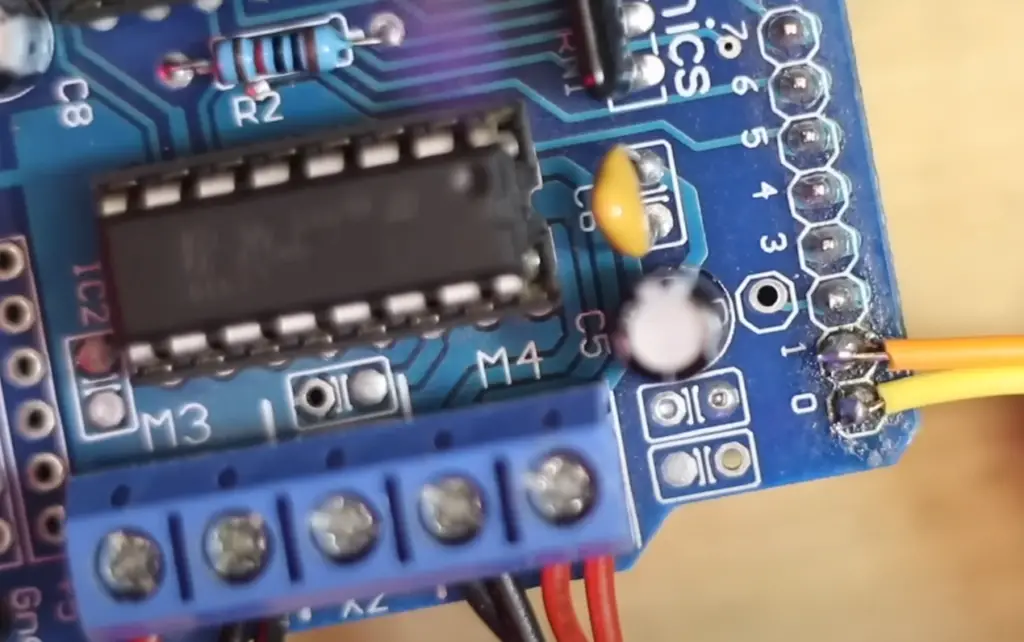
Once you have all of these components gathered together and connected, you’ll want to begin programming your Arduino board. You will need to decide on the logic for your device – how it will follow you around and when it should start/stop emitting air. This can be done using Arduino’s “if” statements and programming language.
Next, you will want to use a smartphone app that will allow you to control the cooler from a distance. This app should have features such as starting and stopping the cooler, setting temperature levels, and coordinating the movements of the cooler with GPS data. Once this is complete, you’ll be ready to give your autonomous “Follow Me” cooler a test run!
A Glove That Translates Sign Language Into Text and Speech
A glove that translates sign language into text and speech is an Arduino Bluetooth-controlled project that can be quite useful for people who are deaf or hard of hearing. To build such a project, you will need the following components:
- Arduino Nano R3;
- Bluetooth Module;
- Accelerometer;
- Mobile;
Utilizing an accelerometer, we can measure the tilt of a hand. To accomplish this, five bend sensors are placed on a glove – four for each finger and one for the thumb. By leveraging sensors to measure the bend in each finger, thumb, and palm of a user’s hand, the Arduino Nano microcontroller is able to interpret which set of values correspond with which symbol. Once this data is received by an Android app via Bluetooth connection, it displays and speaks symbols that were generated accordingly.
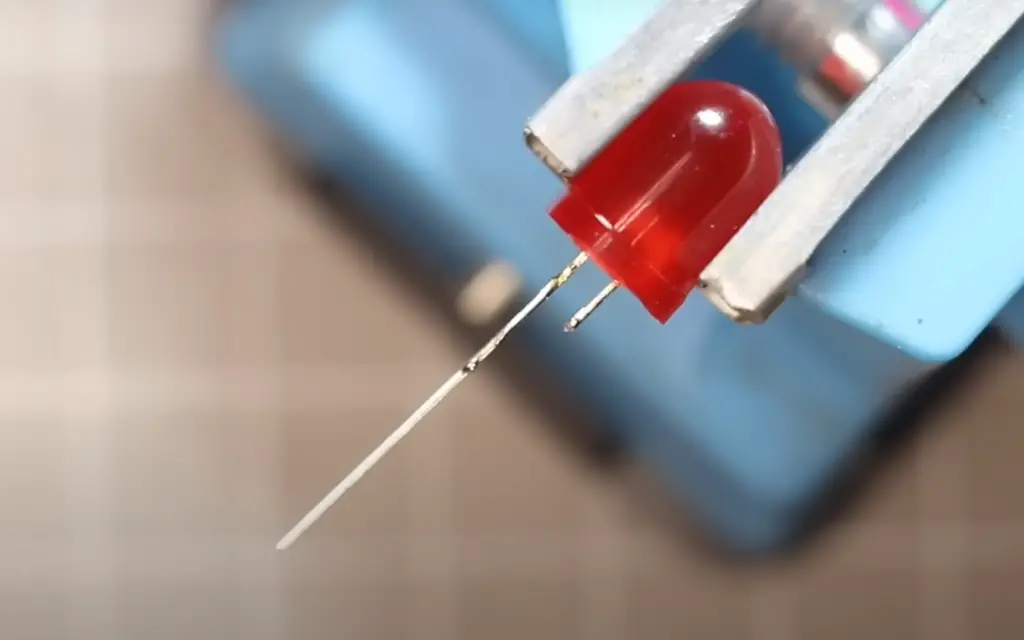
This is a great project as it will enable people to communicate without having to rely on another person’s interpretation of sign language. [2], [3], [4]
FAQ
How to control LEDs using Bluetooth Arduino?
To start the project, it’s necessary to connect the Bluetooth module to your Arduino board. Once connected, you can use an Android device (or other compatible device) to send data that will control the LED on your Arduino board.
To program the Arduino board, you’ll need to upload a sketch that sets up a serial port connection with your device and then defines how it should react when certain data is received from your device. When specific data is sent from your device such as “1” or “0”, the Arduino board will use this to decide whether or not to turn on the LED.
There are tons of online tutorials and resources that can help you get started with this project. Once it is set up, you will be able to control the LED on your Arduino board from anywhere in the world!
How to build a Bluetooth-controlled home automation system using Arduino?
Building a home automation system using Arduino and Bluetooth is relatively straightforward. The first step is to choose the Arduino board that you would like to use for the project. Several different types of Arduino boards are available, each with its own set of features and capabilities. Once you have chosen your board, you will need to download the necessary software libraries for controlling it over Bluetooth.
The next step is to connect all of the components of your home automation system together. This includes things such as lights, sensors, motors, actuators, and more. Depending on what type of home automation system you would like to build, there may be other components needed as well. Once everything is connected, you can then program your Arduino board using the downloaded software. This programming will enable your Arduino board to communicate with the other components of your home automation system over Bluetooth.
Finally, once everything is programmed and connected, you can begin testing your system. You may want to start by creating some basic commands for controlling devices like lights or motors. Once these commands are working properly, you can then move on to more complex tasks such as scheduling tasks for specific times. After testing your system, you should be ready to use it in real-world applications!
How do I add Bluetooth to my Arduino project?
Adding Bluetooth to an Arduino project can be done in a few simple steps. First, you’ll need to get the appropriate hardware for your Arduino board. This includes a compatible Bluetooth module, such as the HC-05 or HC-06, and any other necessary components such as a power source and capacitor. Once you have all of these components, you will then need to wire them up according to the schematic provided with your module. To connect the Bluetooth module to your Arduino board, use the TX and RX pins of both devices. Once wired up properly, you should be able to use software serial commands through your computer’s serial monitor application to configure the settings of the Bluetooth module. After configuring your connection parameters, you can now start developing applications that make use of the Bluetooth connection.
Useful Video: Arduino Bluetooth control car with Front & Back Lights using Arduino UNO, L293D Motor Driver, HC-05
Conclusion
Arduino is a popular platform for creating Bluetooth-controlled projects, ranging from simple home automation to complex industrial applications. Arduino is also relatively easy to get started with, as it can be used with any compatible microcontroller board and programmed using the integrated development environment (IDE).
In this article, we have discussed some of the most common questions and useful tips for getting started with Arduino Bluetooth-controlled projects. We covered topics such as choosing the right board, connecting components, writing the code to control your project, troubleshooting and debugging issues, and more.
When working on an Arduino Bluetooth-controlled project, there are some important considerations to keep in mind. First and foremost, you should ensure that your device is securely connected to the network before attempting any type of communication. Additionally, it’s important to consider power requirements since most devices require a battery backup or additional power source in order to function properly when not connected directly to a mains supply. Finally, security measures such as encryption should always be taken into account when transmitting data over Bluetooth so that your data remains protected from potential attackers.
By following the steps in this guide, you can get your Arduino Bluetooth-controlled project up and running quickly and easily. With a bit of practice, you’ll soon be creating amazing projects for yourself or for others! Good luck and happy coding!
References
- https://learn.sparkfun.com/tutorials/what-is-an-arduino/all
- https://www.watelectronics.com/arduino-projects/
- https://www.hackster.io/andriy-baranov/smartphone-controlled-arduino-4wd-robot-car-14d239
- https://www.hackster.io/173799/a-glove-that-translate-sign-language-into-text-and-speech-c91b13





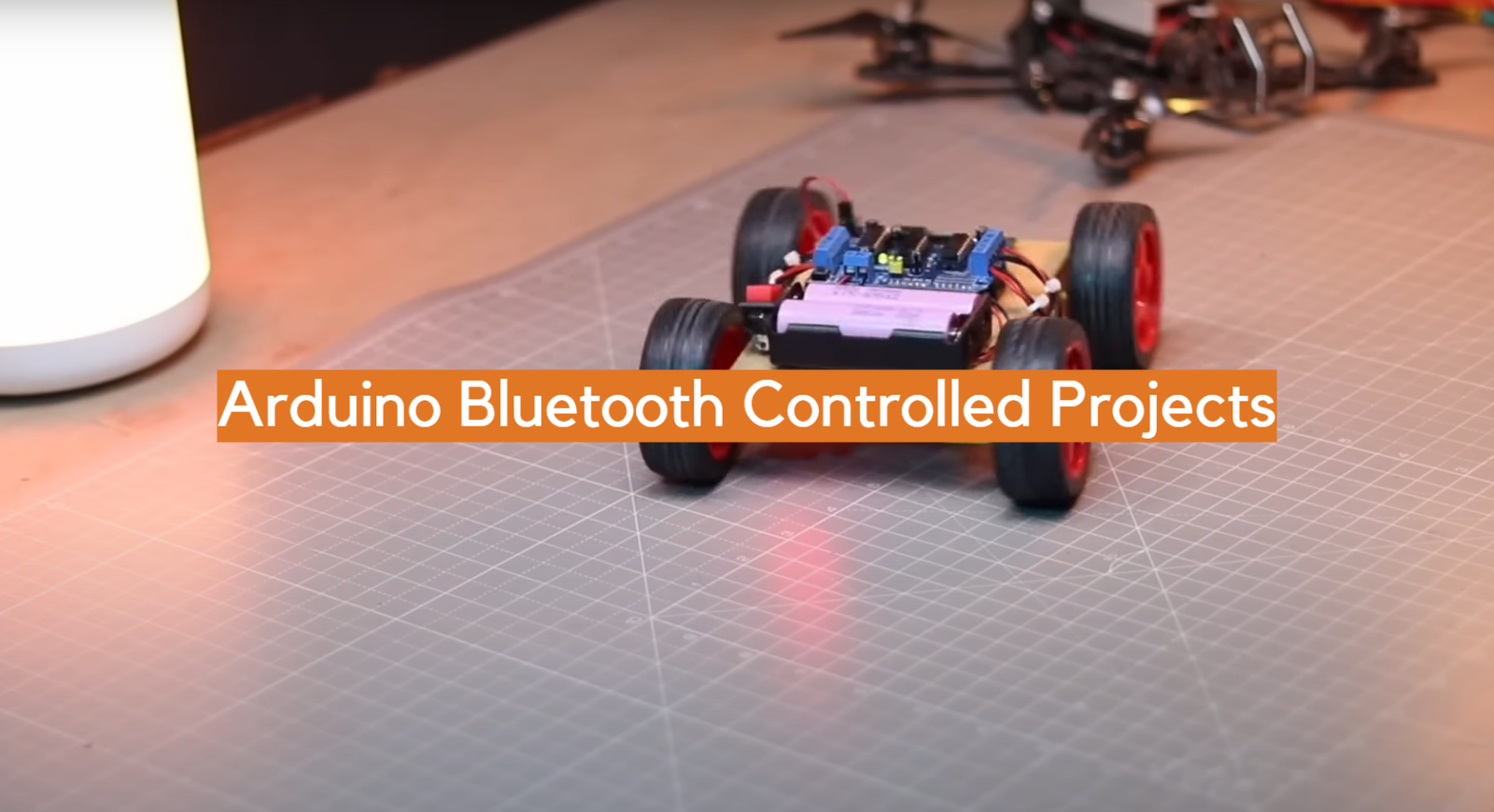







Leave a Reply